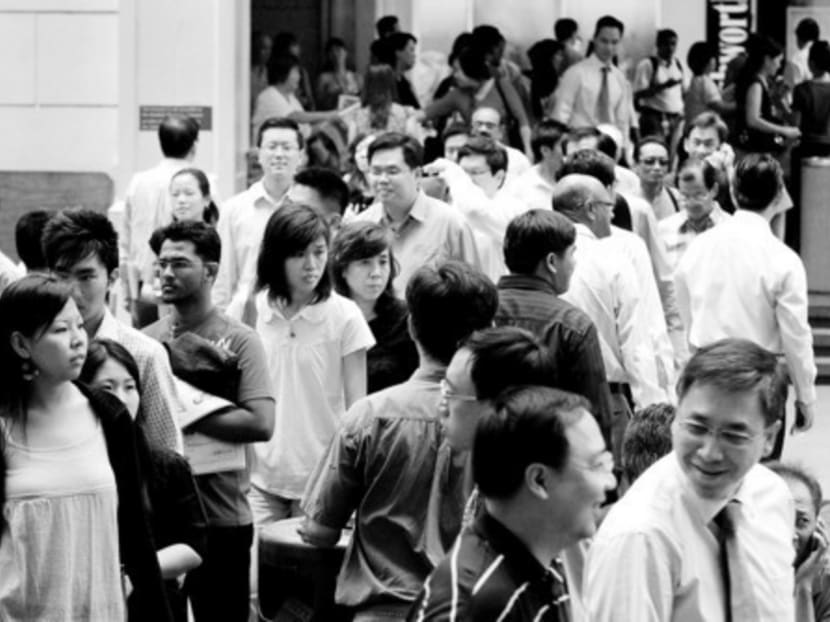How S’pore sustains income growth, tempers inequality and keeps social mobility alive
Underpinning Singapore’s success over the past 50 years has been broad-based social uplifting through a combination of economic and social policies to develop the country’s economy, and Singaporeans’ potential and sense of togetherness, said Deputy Prime MinisterTharman Shanmugaratnam.


Underpinning Singapore’s success over the past 50 years has been broad-based social uplifting through a combination of economic and social policies to develop the country’s economy, and Singaporeans’ potential and sense of togetherness, said Deputy Prime Minister Tharman Shanmugaratnam.
He added that while the country’s focus was very much on economic survival in her early years, social policies started coming to the fore from the 1990s, and, in the past 10 years, a more decisive rebalancing has been made to ensure Singapore remains an inclusive society.
Speaking at a lecture last Friday, Mr Tharman said Singapore’s approach is to provide targeted help to temper inequality, while keeping relatively low overall tax revenues, in contrast to countries like Denmark and Finland, which have achieved large reductions in their Gini coefficients through heavy taxation on the middle-income.
Below is an excerpt from the Economic Society of Singapore SG50 Distinguished Lecture delivered by Mr Tharman, who is also Finance Minister:
The story of Singapore’s first 50 years that is best known internationally is of a remarkable rise in GDP per capita. But that is not the heart of the Singapore story. The unique Singapore story has been that of broad-based social upliftment: Jobs for all, rising incomes for all, homes for all, quality schools and public healthcare for all, and neighbourhoods and parks shared by all.
It is impossible for our economy to have succeeded without effective social strategies — enabling people to develop their potential through education, housing policies that provided a sense of equity, or if everyone was just doing something for themselves and we did not have a sense that we were moving up together. But, it is also impossible for us to have had the very substantial and broad-based improvement in social well-being and life satisfaction without a vibrant economy — and real incomes going up across the whole span of the workforce.
For both low-income and middle-income Singaporeans, real incomes have increased by five to six times since 1965. Economic and social strategies have gone hand in hand, and that is what created the Singapore story.
SUSTAINING INCOME GROWTH
In the first three decades, we focused on the basics. It was about economic survival. It was about providing everyone with opportunities for education, for a job and to own a home, coupled with a very strong emphasis on self-reliance.
The first Budget speech in December 1965, by then-Finance Minister Lim Kim San, was all about survival. It had a detailed assessment of the competition we faced and the constraints we had to reckon with. And one sentence to do with social subsidies: The Mount Emily Girls’ Home was to get 40 more places to give it a total of 85 girls. There was very little explicit support for the poor in those early decades, and a very limited array of social policies. But a whole generation was lifted out of poverty, because our economic strategies worked. Jobs were created, incomes did rise, and homes went up in value steadily as the economy improved.
When we got to the 1990s, social policy was coming more to the fore. The Government began a proactive approach towards helping the lower-income group. Edusave for the young, MediFund for those who could not afford medical expenses and housing grants for the HDB resale market.
But it was in the last 10 years, starting from around 2006, that we made a more decisive shift, a deliberate rebalancing to ensure we remained an inclusive society. We needed to mitigate inequality. We had seen a trend that began from the mid-1990s, where inequality had risen in Singapore. This followed a similar trend in most advanced countries. We wanted to do more to ensure social mobility remained alive, and to help young people to have a real chance of discovering their own strengths and doing well in different fields. And we wanted to provide more assurance for the elderly.
Starting from a decade ago, we began this series of shifts, but still part of that compact between the economic and social strategies. We still had to ensure a competitive economy where incomes could rise, but we paid special attention to ensuring the low-income and middle-income groups kept up as our economy progressed.
All societies would like to sustain income growth, mitigate inequality, and keep their societies fluid and mobile. How have we done? We’ve managed to sustain income growth across the board. It has been unusual among the countries in the same league as us. In the advanced countries, income stagnation has been the norm for the middle-income group.
Among the Asian NIEs, Hong Kong and Taiwan have seen virtually no real income growth for the middle- and lower-income groups in the last decade.
Fortunately, in Singapore, we have managed significant income growth in the last 10 years. Real median income after taxes and transfers here has gone up by 39 per cent in the last decade, compared to 5 per cent in Hong Kong and 3 per cent in Taiwan.
It came about because Singaporeans’ wages went up, and because of increased job opportunities and participation in the labour force — full-time or part-time. For the lower income group, there is a similar trend. In fact, very similar percentages: 37 per cent real income growth for households at the 20th percentile mark.
KEEPING TAX BURDEN LOW
What about inequality? It remains a concern. First, it is useful to have some perspective of what it was like in the old days, and what the trends have been in the rest of world. Inequality was always high in Singapore — we are a city-state. As far back as we have the data, we find that inequality was relatively high in Singapore. It came down some over the course of the 1980s, but beginning in the mid-1990s, we saw a significant increase in inequality, following the trend that had started a decade earlier in virtually every advanced economy.
In our case, starting from the mid-1990s, for a whole decade we saw an increase in inequality. Our level of inequality based on incomes (before taxes and government transfers) is not particularly high by international standards.
The question then is, what happens to inequality after taxes and transfers? Because all governments engage in some redistribution and we do, too.
There are some countries that, in fact, achieve a very large reduction in their Gini coefficients through taxes and transfers. The classic cases are the Scandinavian economies, and to some extent, several other European economies. But, we must recognise that the reduction in their Gini coefficients goes hand in hand with a very heavy burden of taxation on their populations.
Denmark collects about 49 per cent of GDP in taxes, Finland about 44 per cent. In our case it is about 16 per cent. We get some investment income from our reserves, but our tax revenues total just about 16 per cent of GDP. It is not just about taxing the rich, it is the broad middle class in these societies that pay very high consumption and income taxes to generate the tax revenues which the state uses for redistribution. The average worker in Denmark pays an income tax of about 36 per cent, consumption taxes about 25 per cent. Finland has a somewhat similar consumption tax, about 24 per cent. Even if we look at their discounted VAT tiers — for instance, in Finland it is about 14 per cent for food — the average worker pays a lot of taxes.
So that is the basic trade-off. Our approach in Singapore is to keep the overall tax burden low, certainly low by international standards, but within the tax revenues we have, we ensure that we use it in a fair and progressive way by targeting support for the low- and middle- income groups where it helps them most. We must keep the burden of taxes on the middle-income group low. It is high for cars, especially, to control congestion, but we keep income taxes for the middle-incomes and their overall burden of taxes low. Our middle-income households get a fair deal in Singapore. With the enhancements in Budget 2015, they get $2 in Government benefits for every $1 of total taxes they pay (including income tax, GST, property tax and other taxes) — not bad. In the United Kingdom, it is $1.40 of benefits, and slightly lower in Finland. The middle class in these other places does get significant benefits, but pays high taxes.
KEEPING UP SOCIAL MOBILITY
What about social mobility? It is the defining challenge in every advanced country today. We are fortunate that we have so far done relatively well.
Let us look at where people who start off with lower-income family backgrounds end up after they have finished education, and are well into their working lives, around their early 30s. How many of them end up in the top 20 per cent on the income ladder? If everything was equal, if their backgrounds, abilities and how they grow up play no role in eventual incomes, every child would have a 20 per cent chance of ending up in the top 20 per cent.
In the US, among those who are born to lower-income parents, only 7.5 per cent make it to the top 20 per cent. The UK is not very different. In Singapore, 14 per cent of those with lower-income parents end up in the top 20 per cent of incomes. That is higher than in Denmark, and almost twice the US.
So we have a relatively fluid society. But we know it gets more difficult with time, and we will face the same challenges seen in more mature societies. It means we have to work actively to keep up social mobility, find every way, starting from the early years of a child’s life, to help those with a weak start to have a real chance to move up in life.
Few countries have succeeded in sustaining income growth, tempering inequality, and keeping social mobility alive over a long period. For a couple of decades after the World War II, the US and many Western European countries were able to achieve all three — incomes grew for most people, there was a sense that everyone could move up, and they achieved significant reductions in inequality.
It was a special time in history. Young populations, rapid growth; and the US had the GI Bill giving a college education for those who fought in the war. It did not last. Things began to stumble in the late 1970s. Incomes began to stagnate first in the US. Social mobility faltered and inequality began a long rise. I do not say this because we think we are inherently superior to these societies. What happened to them can happen to us. It is a challenge we all face, sustaining income growth and social mobility, while mitigating inequalities.
We have to work hard at it. We must keep our focus on what matters most to people: Having a real chance to develop themselves and move up in life. Focus on maximising opportunities for everyone to do well, and especially for those who start with less. Focus on raising standards of living for all, even as we temper inequalities through redistributing. We must do so with confidence in ourselves, not thinking there is only one model to follow. Stay with strategies that are working well, learn from mistakes, keep improving and keep making a better Singapore.
On Wednesday, TODAY will publish a second excerpt of Mr Tharman’s lecture that focuses on the government’s strategies for Singapore to become both more inclusive and a more innovative society.






